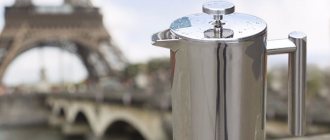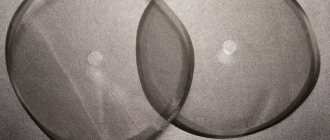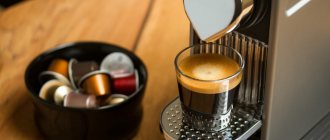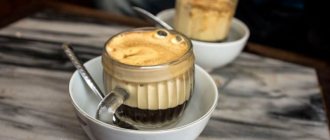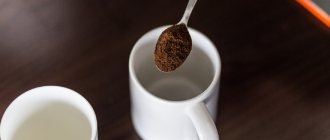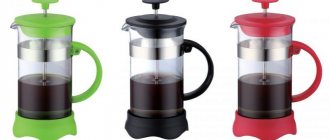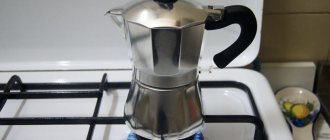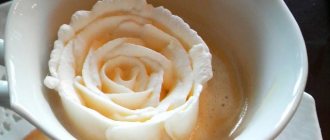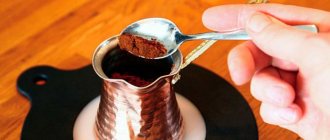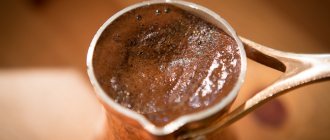Despite the complicated name, a French press is just a regular coffee pot with a press. The device is designed to facilitate the process of making coffee and tea. With the help of a simple device, you will get rid of the inevitable sediment from coffee grounds or tea leaves in your cup of drink. To do this, just brew a drink in a flask and use a piston to separate unnecessary ballast.
What is a French press and why is it needed?
A French press is a kind of kettle for brewing tea and coffee. In Russia, it is associated with tonic leaves, and not with an invigorating powder, but in the USA, the press is ahead of Turks and even coffee makers in popularity.
Pros of the French press:
- Convenience, no need to wash the coffee maker and buy filters;
- Simplicity and speed, just add ground coffee, and in a few minutes the drink is ready;
- Affordable, a kettle with a piston costs less than the most budget coffee maker;
- Careful attitude towards the taste of coffee;
- Preservation of antioxidants, polyphenols and essential oils.
The only drawback of the press is the inability to use it to store finished coffee.
History of the teapot
The technology can hardly be called new: the first French presses appeared back in the 1800s (and yes, in France), although they were far from modern models. At the beginning of the 20th century, the design was noticeably improved in Italy, and by the mid-50s, the French press acquired its modern look, and this was done, again, by the French.
In the post-Soviet space, French presses gained mass popularity already in the 2000s, when they began to be found in literally every tea and coffee store, as well as in kitchenware departments. But at first they were used exclusively for making tea, and coffee was prepared in other ways. And, perhaps, only in the last decade have French presses been used for coffee
What does a French press for coffee consist of?
The device was invented by the French in the 19th century, as they were tired of straining coffee brewed in a Turk. It resembles a teapot. The glass flask for pouring water is equipped with a special piston with a mesh, which squeezes out the grounds during the brewing process.
The top of the kettle is closed with a metal or plastic lid. Presses come in different heights and capacities, but they always have the same diameter.
What does a French press consist of: piston, cap, body, filter
The history of the French press
In 1852, French inventors Mayer and Delforge presented an interesting novelty to the public: a cylindrical vessel with a press intended for brewing coffee. But the device was not successful: due to the imperfection of the press, too much coffee grounds slipped into the cup.
It wasn't until 1928 that Italian designers Atilio Calimani and Giulio Moneta patented an improved French press. In the new model, not just a metal plate was attached to the piston, but a filter mesh, which made it possible to carefully separate the liquid from the grounds. In subsequent decades, the design of the device was improved by attaching a safe handle and a stable base that protected the table cover from heat.
French press assembled
Real popularity came to the manual coffee maker in 1958, when its design was finalized by Faliero Bondanini, and two European companies began production: the French Martin SA (Chambord brand) and the English Household Articles (La Cafetiere brand). Initially, the owner of Household Articles, L. J. de Ville-Castel, was one of the investors in Martin SA, but in the 90s of the 20th century the French company was bought out by the Danish holding Bodum.
How to use a French press
Coffee or tea leaves are poured into the flask, water is added, the piston is inserted and the piston mechanism is moved down. Then the contents are left to infuse and poured as from a regular teapot.
Mocha coffee is a popular variety native to Yemen. It is the progenitor of many coffee cultures.
If you decide to grow Arabica at home and are faced with the fact that its leaves are drying out, then this article is for you.
If you can't drink coffee, try its popular analogue made from acorns:.
It is not recommended to store tea or coffee in a French press; it is better to pour the drinks straight away. Otherwise, the taste of the coffee will be lost.
Disadvantages of using a French press
It is not easy to find flaws in a simple and ergonomic device.
The disadvantages of using a French press include:
- fragility of the teapot if it is glass;
- the need for manual brewing as opposed to a coffee machine;
- There should be a kettle or other device for heating water on hand.
In all other respects, the French coffee pot raises no complaints. By experimenting with different varieties, adding spices, and controlling the brewing time, it’s easy to surprise your loved ones with new tastes.
How to choose a coffee press
There are no special features other than the material for the lid and the height of the French press flask. A coffee press is selected according to the following criteria:
- Material for the flask. The heat-resistant glass of the press will last longer and is protected from cracks, chips, and other mechanical damage;
- Pens. It is better if they are plastic or rubber coated. This will help avoid heating and make brewing convenient;
- Piston quality. The metal should not have burrs or irregularities, the mechanism should fit tightly to the walls of the flask.
A loose French press piston is not always visible to the eye; when purchasing, you can ask to pour water into the flask, and then the defects will become visible when moving.
Do presses vary in price? Yes, kettles from branded kitchen utensil manufacturers can cost as much as a good coffee maker, but nothing distinguishes them except the brand name. The price of about 9,490 rubles per kettle does not make it much better than what is sold for 190 rubles in online stores. The most common presses are 350 ml, allowing you to make two standard cups of Americano or one large one.
Design features of French presses
All teapots are of the same design and consist of five main elements:
- The flask is where the brewing takes place. The most commonly used glass flask is made of heat-resistant borosilicate glass. This is exactly what is used, only thinner, for glass baking dishes. Even a sharp change in temperature or strong sudden heating does not lead to the appearance of cracks. But the flask is not shockproof - if you drop it, or hit the coffee pot too hard, the flask will break. There are also metal flasks, which are much stronger and last, in general, forever, but you need to specifically look for this; there are few offers in stores. There is also ceramics - it is believed that the drink tastes better in it, but again, it is very rare.
- The filter is usually three-layer. At the bottom is a frame, then a metal or nylon fine mesh, and then a metal plate with holes, and usually a twisted catcher along the edge.
- A plunger, also known as a piston, connects the lid and the filter.
- Lid. Just a lid, flat or convex, made of different materials. Most often it is stainless steel, but there is also plastic and glass.
- Body and handle. Usually there is either a bottom or legs that protect the surface from touching the hot flask, and the decor both holds the flask and somewhat protects it from impacts.
Most often on the market you will find glass flasks in a stainless steel body, with a metal handle and lid. As a cheaper option - with plastic components.
What types of drinks can be made in a coffee press?
The classics are preparing Americano, espresso and spiced coffee in a French press. The device can also be used to froth milk for cappuccino, but it is not recommended to brew coffee with milk.
Please note: Only cardamom, nutmeg, ginger or cinnamon are added to the flask. Nothing but spices are added to it during brewing.
You can also make cappuccino in a French press:
- Brew the coffee as you would a regular Americano for 4 minutes;
- Beat the foam;
- Combine them in a cup
How to whip cappuccino foam using a French press:
- Heat the milk;
- Pour it into the flask;
- Move the piston back and forth vigorously for half a minute;
- If the foam does not rise, continue;
- Immediately pour milk foam into coffee
Advantages and disadvantages
When people talk about what a French press is, they usually explain how to use it, but few people reveal all the benefits of this teapot.
So, here are the reasons to start using a French press.
Advantages
- Delicious and aromatic coffee;
- The grounds are filtered out efficiently, but it is precisely this that often causes irritation of the stomach and intestines. And it’s simply more pleasant to drink coffee when the particles don’t stay on your teeth.
- You can brew your favorite coffee wherever there is boiling water. You don’t need a stove or a Turk (see recipe for oriental coffee). And even the water will not be too hot, the drink will be brewed, but there will be no grain particles in it (and this often happens when you brew coffee in a mug).
- Your coffee is guaranteed not to burn or run away. Very convenient for those who are distracted from the Turk for a second and then have to wash the stove.
- Even a child can handle preparing the drink. It’s difficult for him to keep track of the Turk, and the stove needs to be turned on, but for a French press you just need to press the button on the electric kettle, boil water, pour it into the flask and cover with a lid.
- Unlike coffee machines, due to the long brewing time, the French press allows the maximum amount of oils, flavors and aromatic compounds to pass into the water (see the chemical composition of coffee). You will be surprised how rich and deep the taste of your favorite drink will be.
- You can adjust the strength of the coffee (depending on the infusion time);
- Low price;
- Easy to care for;
- The ability to add spices immediately while preparing the drink;
- Does not consume electricity;
- Compactness;
- Multifunctional (suitable for making tea, tea drinks, etc.).
Flaws
- Manual method of preparing the drink;
- You must additionally have a kettle or other device for heating water;
- You cannot store the drink in it for a long time to avoid oxidation and damage to the parts of the French press.
Caution: If you are used to espresso from a coffee machine (see espresso recipe), the drink from a French press may be too strong for you.
Grinding and coffee
The French press is picky about the grind and type of coffee. The higher the quality of the grain and the more suitable grinding method, the more shades of flavor the press will retain. For brewing, take coarsely ground coffee, the diameter of the particles is the same as sea salt. A coarse grind will make the drink pure.
Coffee will taste better if you grind it before brewing, use soft bottled water rather than tap water, and purchase quality beans.
Finished ground beans should not be stored for more than 3 weeks, so French press lovers buy coffee in small “batches.” We have already written about how long coffee can be stored.
Proper grinding of coffee for a coffee press
What it is?
How to use such a device and what is it? The name itself is quite interesting. The device is actually very simple. A French press is a glass container with a coffee filter. It was invented to obtain a drink by infusion and extraction.
Equipment was put up for sale in stores at the beginning of the twentieth century. The first French coffee pot was nothing more than a glass vessel with a piston in the form of a mesh, when pressed, the liquid was separated from the grounds. The principle of its operation has not changed to this day. And externally, the first models are not much different from the current ones.
The French press is said to have been invented by a Frenchman sometime in the early nineteenth century. Back then, coffee was brewed using the simplest method. As always happens, the invention itself happened completely by accident. The story goes that a man boiled water and then added ground coffee. Naturally, he surfaced. Trying to clear the drink of impurities, the Frenchman decided to use a strainer to press the ground coffee to the bottom. Of course, later the design of the device was improved.
What supplements can you use?
The rules are simple - only a drop of sea salt, spices and coffee are placed in the press. Everything else (liqueurs and cognac, milk, cream) is poured into a cup.
The following French press additives can dramatically change the flavor:
- Sea salt removes excess bitterness and makes coffee more aromatic. It is added literally grain by grain to coffee when brewing;
- Cinnamon adds a mild sweetness and warm taste without adding sugar or honey;
- Cardamom enhances bitter notes and imparts a spicy aroma;
- Nutmeg is suitable for those who love a strong taste with bitterness;
- Cloves are rarely added, but their use can turn ordinary coffee into a real “tonic bomb.”
How to brew coffee correctly: step-by-step instructions
Ingredients – 300 ml water, 17-25 g freshly ground coffee
- Step 1. Boil the water and cool it so that the bubbles go away and it sits in the kettle for about a couple of minutes without boiling. This will be the temperature 90 degrees.
- Step 2: Rinse the French press flask with hot water, holding it gently away from you. Add 17 g of ground coffee to 350 ml of water, or a little more if you need espresso.
- Step 3: Fill the coffee grounds with water.
- Step 4: Insert the plunger and gently push it down.
- Step 5. For a standard Americano, brew for 4 minutes, for espresso – a little longer, so that the taste acquires the necessary bitterness
- Step 6: Immediately pour into a cup and enjoy. It is better not to store coffee brewed in a French press.
Step-by-step instructions for brewing coffee in a French press
French press: a device for the lazy or a godsend for advanced coffee connoisseurs?
Among the many devices for making coffee at home, the French press is considered one of the most underrated. Although it was invented specifically for quickly preparing coffee, in Russian kitchens it is most often used as a teapot (often for flower and herbal teas). But in vain!
Professionals are confident that a French press is ideal for bringing out the taste of good grain simply and without any extra effort.
Who should choose a French press?
The French Press is ideal for Specialty lovers. The same ones that distinguish shades of ripe cherries, almonds, Ecuadorian chocolate and freshly baked bread. Or for those who want to learn the basics of cupping at home.
However, if you like oil-thick, rich Turkish coffee or bitter espresso from a geyser coffee maker, it’s still worth trying a French press.
Firstly,
so that your receptors learn to distinguish more subtle shades of taste.
In the second case,
the French press is used by those who do not have the opportunity to brew coffee on a stove or in a coffee machine, and do not want to drink instant coffee.
And thirdly,
it is loved by those who prefer homemade coffee without coffee grounds at the bottom of the cup. And this, you see, is a weighty argument.
The coffee turned out tasteless. Who is guilty?
- Unrinsed French press. It sounds trivial, but it is a poorly cleaned French press piston that gives the drink a musty smell that scares off coffee lovers. After each preparation, the coffee pot should be thoroughly rinsed, and before you start cooking, you can pour boiling water over it.
- Grind too fine. Finely ground coffee somehow ends up in the cup (and clogs the filter). And the finer the grind, the faster the extraction process occurs, and it is easy to “overexpose” the coffee, resulting in a bitter aftertaste. Our experts also recommend coarse grinding because it makes it much easier to lower the piston without much effort.
- Brewing time is too long. Coffee also becomes bitter and tasteless if it is extracted for too long. You cannot keep coffee in a French press for more than 4 minutes, as the coffee loses its flavor and begins to taste bitter.
French press Olaff “Coffee”, 350 ml (art. 116-24033) -15%
494 rub. 581 rub.
French press Guterwahl “Geometry”, 1000 ml (art. 116-24004) -15%
833 rub. 979 rub.
French press Resto Kitchenware, 800 ml -15%
850 rub. 1000 rub.
French press Samadoyo F-125, volume 360 ml 1800 rub.
View all French presses
You will say that the coffee itself may also be to blame, and you will be absolutely right. We remind you once again that elite varieties with fruit or berry notes are well revealed in the French press.
Tips for making coffee in a French press from tea.ru experts
For a French press, you need coarsely ground coffee, roasted as freshly as possible. A cezve and a geyser coffee maker can forgive “stale” grains: the first can be saved by added spices, and the second suggests a slight bitterness in itself. But the French press is aimed specifically at revealing the taste, and therefore needs the best coffee.
It is not recommended to brew coffee with boiling water, as in this case the aromatic components of the coffee may be destroyed and the drink will lose most of its taste and smell. The ideal water temperature is 90-95 degrees (you need to hold the kettle open for 10-15 seconds).
When brewing in a French press, you need to stir the coffee twice. The first time is immediately after you have added water so that there are no dry particles left. The second time - after the end of brewing, so that large particles sink to the bottom and do not fall into the cup.
The ideal coffee to water ratio is 7 grams per 100 ml. (a 300 ml French press takes 21 grams or 3 heaped teaspoons). You can watch a video recipe for making French press coffee here.
And do not forget that the French press can be used for purposes other than its intended purpose. For example, to make a cappuccino or latte at home:
How do you use a French press: for tea or coffee?
Useful tips
A press is also suitable for whipping milk foam in cappuccino or latte. But if you need to save time, it is better to take an additional small French press and whip milk foam in it at the same time as brewing in another.
The press will last longer if you throw away the grounds immediately after brewing and rinse it well under running water, not forgetting about the piston and lid. It is enough to use warm water if you are not pouring milk into the flask.
The taste of spices “from the previous brewing” may remain on the walls of the coffee press, so after preparing coffee according to original recipes, it is better to soak all the parts of the mechanism in moderately hot water for a while. This will help wash away the essential oils and avoid mixing flavors when brewing again.
Tip: It is useful to have two presses at home - one strictly for coffee, the other for tea. Over time, the piston retainers can “absorb” the coffee flavor, and thin varieties of tea will smell different when brewed.
Cortado coffee is considered one of the best baked milk drinks. Italy is considered its homeland, but if you are not planning to visit this country in the near future, you can prepare cortado at home.
Turkish coffee with milk is not a complicated and extremely tasty recipe, which you can find here:.
Description
French press (English french press - “French press”) - due to its ease of use, this is one of the most common devices for brewing coffee, which is popular all over the world. This is a container in which you put coffee, fill it with water, let it brew, and then lower the piston with a filter at the end to separate the coffee grounds from the water.
The filter is usually made of metal, sometimes nylon. It allows natural oils and fine coffee particles to seep into the water, unlike paper.
For cooking you do not need any special electrical appliances, paper filters or other accessories. All you need is a French press, hot water and ground coffee.
The taste of coffee made in a French press
If coffee is brewed in a press longer, it will acquire a more bitter and rich taste and strength. Standard 4 minutes - for Americano with dense shades of essential oils and the velvety aftertaste of natural coffee. Intensive roasting of the beans enhances the flavor and oily component. The result is most reminiscent of coffee prepared in a Turk or with sand, rather than a “machine-made” Americano.
Video instruction:
The French press is a convenient tool that even a child can handle. It is important to choose high-quality raw materials, use coarse grinding and soft water. The drink will be richer if you leave it for longer than 4 minutes. But you shouldn't store it. The press is an alternative to a Turk or coffee pot, but retains all the subtleties of the taste of coffee with a full range of natural essential oils.
